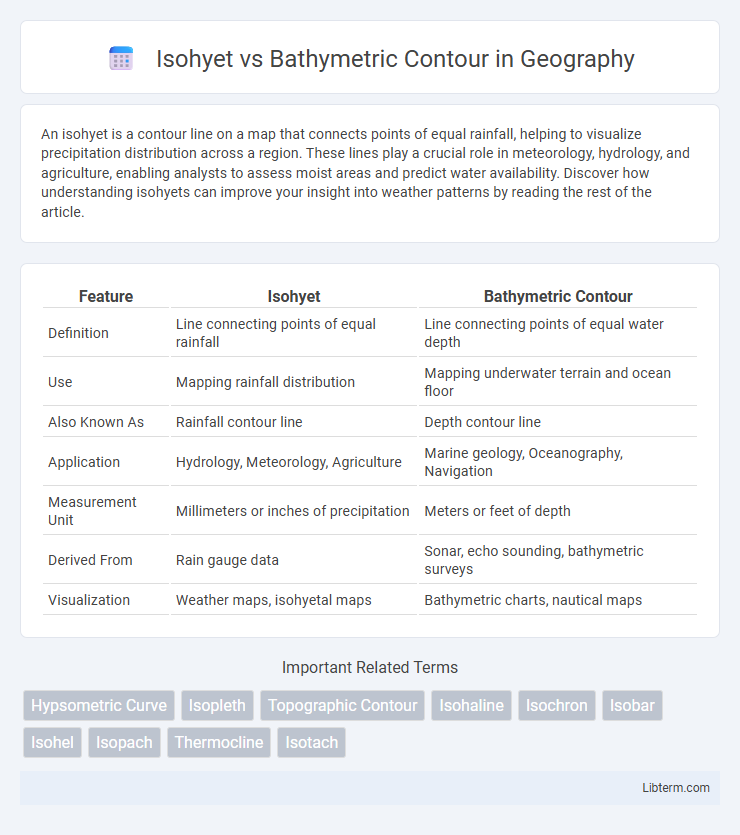An isohyet is a contour line on a map that connects points of equal rainfall, helping to visualize precipitation distribution across a region. These lines play a crucial role in meteorology, hydrology, and agriculture, enabling analysts to assess moist areas and predict water availability. Discover how understanding isohyets can improve your insight into weather patterns by reading the rest of the article.
Table of Comparison
| Feature | Isohyet | Bathymetric Contour |
|---|---|---|
| Definition | Line connecting points of equal rainfall | Line connecting points of equal water depth |
| Use | Mapping rainfall distribution | Mapping underwater terrain and ocean floor |
| Also Known As | Rainfall contour line | Depth contour line |
| Application | Hydrology, Meteorology, Agriculture | Marine geology, Oceanography, Navigation |
| Measurement Unit | Millimeters or inches of precipitation | Meters or feet of depth |
| Derived From | Rain gauge data | Sonar, echo sounding, bathymetric surveys |
| Visualization | Weather maps, isohyetal maps | Bathymetric charts, nautical maps |
Introduction to Isohyets and Bathymetric Contours
Isohyets are lines on a map connecting points of equal rainfall, crucial for meteorological analysis and hydrological studies. Bathymetric contours, by contrast, represent lines of equal water depth on underwater topographic maps, essential for marine navigation and oceanographic research. Both types of contours provide valuable spatial data but serve distinct purposes in environmental science and geographic mapping.
Defining Isohyet: Meaning and Purpose
An isohyet is a contour line on a map that connects points of equal rainfall intensity or precipitation, serving as a crucial tool in meteorology and hydrology for analyzing spatial distribution of rainfall over a region. It helps in understanding precipitation patterns, aiding water resource management, flood forecasting, and agricultural planning. Unlike bathymetric contours that depict underwater terrain depth, isohyets specifically relate to atmospheric moisture data and rainfall measurement.
Understanding Bathymetric Contours
Bathymetric contours are lines on a map that connect points of equal underwater depth, helping to visualize the topography of the ocean floor, lakes, or other bodies of water. Unlike isohyets, which represent equal precipitation levels over land, bathymetric contours provide crucial data for marine navigation, underwater construction, and environmental research by illustrating variations in underwater terrain. Accurate interpretation of bathymetric contours supports the identification of features such as underwater mountains, trenches, and plateaus essential for oceanographic studies and habitat mapping.
Key Differences Between Isohyets and Bathymetric Contours
Isohyets represent lines of equal precipitation on a map, highlighting spatial rainfall distribution, whereas bathymetric contours indicate lines of equal water depth, mapping underwater terrain. Isohyets are critical in hydrology and meteorology for analyzing rainfall patterns, while bathymetric contours are essential in marine geography and oceanography for understanding seafloor topography. These two types of contours differ fundamentally in their data sources, applications, and the natural phenomena they illustrate.
How Isohyets Are Created: Methods and Tools
Isohyets are created by plotting points of equal precipitation collected from rain gauges and interpolating values between these points using Geographic Information Systems (GIS) and kriging techniques. Meteorologists employ remote sensing data and Doppler radar to enhance accuracy in mapping rainfall distribution over a given area. These methods allow for the precise delineation of precipitation gradients, distinct from bathymetric contours which represent underwater elevation levels.
Techniques for Drawing Bathymetric Contours
Bathymetric contour drawing techniques involve gathering precise depth measurements using sonar, multibeam echosounders, or LiDAR systems to map underwater terrain accurately. Data points are processed through Geographic Information Systems (GIS) or specialized software like ArcGIS and QPS Qimera to interpolate contour lines representing consistent underwater depths. Unlike isohyets that represent equal rainfall, bathymetric contours require integrating hydrographic surveys and digital elevation models (DEMs) to visualize the seafloor's morphology effectively.
Applications of Isohyets in Meteorology and Hydrology
Isohyets, which represent lines of equal precipitation, are essential in meteorology for analyzing rainfall distribution and forecasting weather patterns. In hydrology, isohyets help quantify watershed precipitation, aiding in flood prediction and water resource management. Bathymetric contours, by contrast, map underwater terrain and are primarily used in oceanography and marine navigation rather than atmospheric or hydrologic studies.
Uses of Bathymetric Contours in Oceanography
Bathymetric contours represent underwater topography, crucial for mapping the seafloor's depth variations in oceanography. These contours help identify underwater features such as trenches, seamounts, and continental shelves, facilitating navigation, habitat studies, and resource exploration. They are essential for modeling ocean currents, understanding sediment transport, and planning underwater construction projects.
Advantages and Limitations of Isohyets and Bathymetric Contours
Isohyets provide accurate visualization of spatial rainfall distribution, essential for hydrological assessments and flood management, but their accuracy depends heavily on the density of rainfall measurement stations, making interpolation less precise in data-sparse regions. Bathymetric contours offer detailed representation of underwater topography, crucial for navigation, marine construction, and habitat studies, yet they can be limited by the resolution of sonar or satellite data, potentially missing fine-scale features. Both tools enhance environmental analysis but require high-quality input data to maximize their effectiveness in outlining precipitation patterns or underwater terrain.
Summary: Comparing Isohyets and Bathymetric Contours
Isohyets represent lines of equal precipitation on weather maps, crucial for hydrological studies and rainfall distribution analysis. Bathymetric contours depict underwater depth variations, essential for marine navigation, oceanographic research, and seabed mapping. While both use contour lines, isohyets measure atmospheric data, whereas bathymetric contours map submarine topography.
Isohyet Infographic

 libterm.com
libterm.com